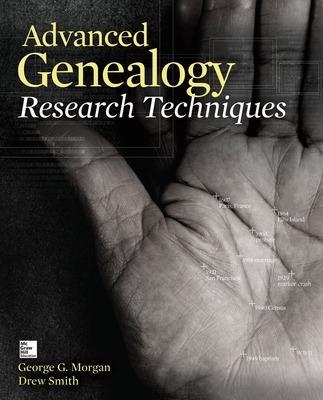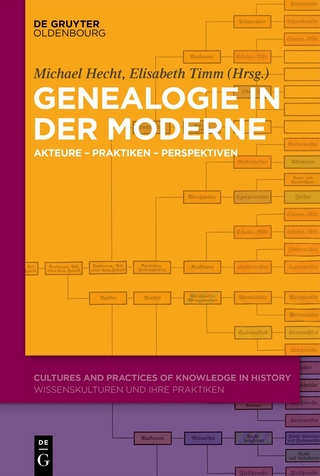
Advanced Genealogy Research Techniques
Osborne/McGraw-Hill (Verlag)
978-0-07-181650-2 (ISBN)
Publisher's Note: Products purchased from Third Party sellers are not guaranteed by the publisher for quality, authenticity, or access to any online entitlements included with the product.
Break through brick walls in your genealogical research"Easy to read, provides clear explanations, examples and is well-illustrated, thus definitely meeting the needs of libraries and individuals seeking a book to guide family historians who are beyond the basics and need help solving problems."--FORUM magazine
Learn how to use innovative methods to unearth hard-to-find ancestors. Advanced Genealogy Research Techniques shows you, step by step, how to uncover elusive details by taking advantage of specialized tools and software programs and using proven best practices for breaking through the brick walls that have hindered your progress.
You’ll get professional advice on formulating a research strategy, understanding the details you discover, keeping careful track of your data, analyzing the evidence, and developing hypotheses. Real-world case studies demonstrate how you can apply the systematic procedures presented in this practical guide to your own research--and achieve success!
Examine the brick wall in detail to find potential weak spots that can be exploited into a breakthrough
Use brute force techniques that leave no stone unturned
Obtain exact copies of original records rather than derivative sources
Research the family, associates, and neighbors (FANs) of your brick wall ancestor
Consult with your family, friends, and colleagues to get a fresh perspective on your research
Use crowdsourcing--genealogy societies, online forums, social media, blogs, wikis, and podcasts
Apply technological solutions, including DNA testing and specialized genealogical software
Get tips on hiring a professional genealogical researcher with the appropriate credentials and references
Revisit your brick wall problem after honing your research skills
Review your evidence, develop a research strategy, and keep a meticulous research log
George G. Morgan is president of Aha! Seminars, Inc. In addition to his extensive responsibilities with Aha! Seminars, Inc., George is an avid genealogist. His interest began at age ten when he and his paternal grandmother and aunt divulged his paternal history extending back before the American Revolution. In the years since then, George’s genealogical research has expanded to include all the branches of his family tree and he has investigated leads in materials in all sorts of places. Libraries, archives, and courthouses are among his favorite haunts, but he will leave no stone unturned, even to the point of tracking down the original 1914 newspapers containing his great-grandparents’ obituaries in a records retention facility owned by a county board of education. He is a master in working with and understanding all types of genealogical record types in the U.S., Canada, the United Kingdom, and Australia. With the advent of electronic research materials, he has become an recognized expert in using software programs, databases, Internet resources, online databases, Internet genealogical mailing lists and message boards, search engines, directories, subscription databases, and all the major online services around the world.George is the author of seven landmark genealogy books. These include: The Genealogy Forum on America Online: The Official User’s Guide; the award winning Your Family Reunion: How to Plan It, Organize It, and Enjoy It, both published by Ancestry Publishing. His award-wining book, How to Do Everything with Your Genealogy, published by McGraw Hill as part of the highly successful “How to Do Everything” series, is now available in its fourth edition. This book is one of the best-selling genealogy “how-to” genealogy books published in the last 20 years! George has also written the first and second editions of The Official Guide to Ancestry.com. His Genealogical Research in the Major Repositories of London, published through Lulu.com, has sold hundreds of copies.George is a prolific writer in other areas as well. He began in 1996 by writing the award-winning weekly online genealogy column, “Along Those Lines…” that appeared first in the Genealogy Forum on America Online and then exclusively at the Ancestry.com web site from January 2000 to March 2006, and additional columns for Ancestry Daily News. He also appears weekly in the Plus Edition of Eastman’s Online Weekly Newsletter, at the bi-monthly electronic genealogy magazine Digital Genealogist, in the Ancestry Weekly Journal at Ancestry.com, and at other online venues. He has written literally hundreds of articles for genealogy print magazines: Ancestry Magazine, The Association of Genealogists Quarterly, Discovering Family History, Everton’s GenealogicalHelper, Family Chronicle Magazine, Family Tree Magazine, The Federation of Genealogical Societies FORUM, Genealogical Computing (published by Ancestry Publishing), Heritage Quest Magazine, Internet Genealogy, The NGS News Magazine, and Southern Queries Magazine. His other online venues over the last decade have included Sony Communications’ Emazing.com “Genealogy Tip of the Day” and a stint with ChineseRoots.com. George is a popular speaker at international genealogical conferences and has presented all across the United States in national, state, and local conference. He also has presented in Canada, in the U.K., and on several international genealogical cruises. His range of genealogical interests and speaking topics is among the most diverse among the genealogical speaking community. Drew Smith (Odessa, FL) has been a librarian in the Academic Services department at the University of South Florida (USF) Tampa Library since 2007. Between 1994 and 2007, he was an instructor for the USF School of Library and Information Science (now the School of Information), where he taught undergraduate-level courses in library/Internet research skills and website design, and graduate-level courses in genealogical librarianship and indexing/abstracting. Drew has been a volunteer in the America Online (AOL) Genealogy Forum, writes regular genealogy articles for Genealogical Computing, Digital Computing, and NGS NewsMagazine (now NGS Magazine). He also served as the editor of the FGS Voice (formerly the FGS Delegate Digest), the newsletter of the Federation of Genealogical Societies. In 2009, Genealogical Publishing Company published his first genealogy book, Social Networking for Genealogists. Drew currently serves as the President of the Florida Genealogical Society of Tampa, and as a Director of the Federation of Genealogical Societies. He served as Secretary of the Association of Professional Genealogists from 2010 to 2011, and continues to serve as one of its mailing list administrators. In 1996, Drew founded the mailing list GENEALIB for genealogy librarians, and continues to administer it for more than 1100 subscribers. Drew regularly speaks at conferences and meetings of national, state, and local genealogy societies, especially on topics linking genealogy and technology. Together with George G. Morgan, Drew has been the co-host of the Genealogy Guys Podcast since September 2005
Introduction
When the Going Gets Tough…
…the Tough Get Going
The Brick Wall Metaphor (and Why It Matters)
Eight Ideas for Getting Past the Brick Wall
What You’ll Need Before You Set Out
Chapter 1. Examine the Brick Wall in Detail
Reexamine in Detail the Evidence You Have Already Discovered
Focus on Details You May Have Missed or Overlooked the First Time
Census
Birth Certificate/Index
Marriage License/Index
Death Certificate/Index
Obituary
Tombstone/Cemetery
Photograph
Now That You Have More Details…
Organize What You Have in a Genealogy Database Program
Names
Dates
Places
Create an Ancestor Timeline
Gather All of the Evidence You Have Collected
Organize Everything Sequentially
Reread Everything
Compile a Timeline
Incorporate Historical Newspaper Research
Example 1
Example 2
Example 3
Summary
Sources Used in This Chapter
Chapter 2. Use Brute Force
Indexes
Transcriptions
Extracts
Abstracts
OCR in Detail
Sources of Secondary Information
Family Histories, Online Family Trees, and Personal Web Pages
Application Forms to Societies and Other Organizations
The “Reasonably Exhaustive Search”
Example 1
Example 2
Example 3
Summary
Sources Used in This Chapter
Chapter 3. Go Around the Wall
The Broader Technique (and What to Call It)
Spouses
Parents and Children
Other Relatives
Beyond the “F”
Another Important Use of the FAN Club Technique
Other Names
Example 1
Example 2
Example 3
Example 4
Summary
Sources Used in This Chapter
Chapter 4. Talk to a Friend
Why Share a Brick Wall Problem?
With Whom Should You Share the Problem?
How to Share a Brick Wall Problem
Example 1
Example 2
Example 3
Summary
Chapter 5. Use Crowdsourcing
Genealogy Societies
Online Forums—An Overview
Electronic Mailing Lists
Electronic Message Boards
Facebook Groups, Google+ Communities, and GenealogyWise
Finding the Most Relevant Online Forum
The Etiquette of Online Forums
Blogs, Wikis, and Podcasts
Blogs
Wikis
Podcasts
Example 1
Example 2
Example 3
Example 4
Summary
Chapter 6. Apply Technological Solutions
DNA Testing: A Very Brief History
Types of DNA Testing
mtDNA Testing
Y-DNA Testing
Autosomal DNA Testing
Deep Ancestry
Mutations
Mitochondrial Eve
Y-chromosomal Adam
Haplogroups and SNPs
Ethnic Mixtures
Companies That Perform DNA Testing
Specialized Genealogical Software
GenSmarts
Clooz
Evidentia
Summary
Chapter 7. Hire a Demolition Expert
What Can a Professional Researcher Do for Me?
Professional Genealogist
Accredited Genealogist
Certified Genealogist
Other Organizations Representing Professional Genealogists
Geographic Specialization
Specialty Areas
Contracting with a Professional Researcher
If and When Things Go Wrong
Summary
Chapter 8. Rest Up and Attack the Brick Wall Another Time
Learn
Books
Articles
Blogs
Wikis
Recorded Audio and Video Programs
Live Webinars
Face-to-Face Presentations
Practice
Monitor
Summary
Chapter 9. Put the Techniques to Work
Review the Evidence
Develop a Research Strategy
Determine the Questions You Want to Answer
Identify All Potential Resources
Obtain Exact Copies of the Original Records
Analyze Evidence and Develop Hypotheses
Keep a Research Log
A Paper Research Log
Use a Spreadsheet
A Blog as Research Log
Use Your Genealogy Database Program
Software Utility Programs
The Case of Mary Ann Reilly Smith
Some Final Remarks
Index
| Erscheint lt. Verlag | 16.9.2013 |
|---|---|
| Zusatzinfo | 50 Illustrations |
| Verlagsort | New York |
| Sprache | englisch |
| Maße | 218 x 229 mm |
| Gewicht | 398 g |
| Themenwelt | Sachbuch/Ratgeber ► Freizeit / Hobby |
| Sachbuch/Ratgeber ► Geschichte / Politik ► Regional- / Landesgeschichte | |
| Sachbuch/Ratgeber ► Gesundheit / Leben / Psychologie ► Familie / Erziehung | |
| Schulbuch / Wörterbuch ► Lexikon / Chroniken | |
| Geschichte ► Hilfswissenschaften ► Genealogie | |
| Mathematik / Informatik ► Informatik ► Web / Internet | |
| ISBN-10 | 0-07-181650-X / 007181650X |
| ISBN-13 | 978-0-07-181650-2 / 9780071816502 |
| Zustand | Neuware |
| Haben Sie eine Frage zum Produkt? |
aus dem Bereich
